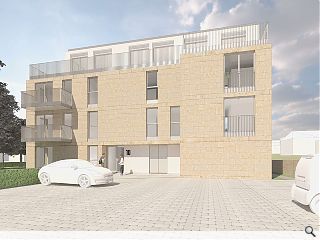Blackhall manse to make way for 11 flats
March 3 2022
An unlisted turn of the century manse on Columba Road, Blackhall, could be demolished to make way for 11 apartments to maximise the intensity of its large corner plot.
Originally built to serve nearby St Columba's Church the manse has lain vacant for over three years, making it a target for redevelopment.
A project team including Comprehensive Design Architects and Wardell Armstrong have been assembled to achieve this by erecting an apartment block on the 1,400sq/m site.
Outlining the rationale behind demolition the applicant wrote: "Due to the nature and extent of the ad-hoc changes made to the property throughout the years and the amount of work that would be required to improve the fabric and thermal properties of this building to meet current standards, retention was deemed unviable.
"Although retaining the existing building would have a lesser impact on embodied carbon at the outset, in the long term, replacing the existing building with a more efficient building - which takes advantage of renewable technologies— will reduce the operational energy, and offset the initial carbon outlay, while also offering a higher standard of accommodation with more economical running costs for residents."
Replacement accommodation will be faced in buff ashlar sandstone below a fibre cement penthouse floor set back behind a roof terrace. A recessed communal entrance porch will be finished in white glazed brick.
7 Comments
It’s a nice house but the climate crisis throws up some conundrums yet to be settled.
A conversion of this site could yield 5 dwellings without the need for demolition.
I don't really think anyone is making subjective claims or counter claims; we're just commenting on the information as presented.
The existing and proposed site plan make it fairly evident that with a bit of creative extension/remodelling the existing property could be adjusted to accommodate all 11 (totally abstract number) apartments. The roof could be removed and still replaced with 'penthouse' level apartments.
The main argument is retention isn't 'unviable', as suggested. It just doesn't work for this particular developer. I've, personally, no problem with the developer making as much money as they wish (they are taking the risk after all). But i would prefer if they were honest about it rather than trying to hide a commercial decision in amongst an environmental justification. All that does is dilute the pressing environmental discussion that needs to happen.
Post your comments
Back to March 2022
Like us on Facebook
Become a fan and share





"Although retaining the existing building would have a lesser impact on embodied carbon at the outset, in the long term, replacing the existing building with a more efficient building - which takes advantage of renewable technologies— will reduce the operational energy, and offset the initial carbon outlay, while also offering a higher standard of accommodation with more economical running costs for residents."
Let's just unpack that a little. The existing building is roughly 120 years old. It's not unreasonable for there to have been 'ad-hoc changes' over that length of time. How long will the proposed building need to be there for to actually 'offset the initial carbon outlay'?
Furthermore, the existing building is more than capable to 'taking advantage of renewable technologies'. It's just as simple to add PV to an old roof as a new one. An ASHP will be the same if it's plugged into an old or a new building. With a little bit of careful consideration the fabric could be significantly upgraded and windows etc.. replaced with triple glazed units. Once the building is refurbished to a high energy efficient standard and has renewable technologies plugged in is it actually true to say that a new building will reduce the operational energy. The same people will live in the building so their energy consumption will be what it is. If the heating is marginally more expensive in a newly completed refurb it will be a very, very long time indeed before the new build offsets the embodied carbon associated with demolition and new construction.
If the applicant actually means it's just easier for us to bulldoze this and building a new building that lets us sell flats easily then they should simply say so. Don't be embarrassed about suggesting you are looking to develop the site for profit. But don't try and hide the true motive behind an environmental agenda.
The simple fact is the refurbishment of the building is only 'unviable' for this particular developer. That is not the same as the refurbishment being unviable to all.